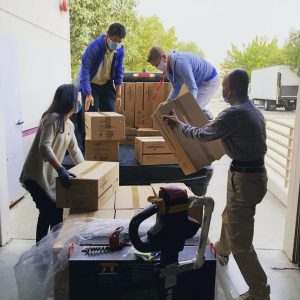“We know from decades of research that strong social connections and a reason to get up in the morning are key to our well-being as we age – we need to get past the idea of ‘stay safe and stay out of the way’ ” says Marc Freedman, President and Founder of Encore.org, a non-profit working to bridge generational divides.
People have always contributed to improving the lives of others whether by informal or formal volunteering in a local community or more widely in the world. We now live longer than previous generations – the ways we maintain our social connections, build community relationships and use our time is changing, often driven by different social and cultural norms around civic engagement.
Why volunteering is good for us
In general, having strong social ties can have a powerful effect on people’s well-being. There is ample evidence, outlined in research work of the Stanford Center on Longevity[1], showing the relationship between satisfying social connections and health outcomes. The Stanford University Wellness for Life[2] project demonstrates that social connectedness is a key contributor to overall life satisfaction, more critical than other significant factors such as material status and physical health. The research is clear – people who volunteer lead longer, healthier lives. Some public-health experts now advise doctors to recommend a “social engagement” prescription alongside diet and exercise[3].
What are the health benefits?
The need for social connection does not fade with age. And there are obvious gains for communities and society at large. For older volunteers, social engagement through volunteering activities benefits physical, mental and cognitive health – all contributors to healthy longevity. In the US, Encore.org was involved in the original design of the successful Experience Corps programme. It involves older adults tutoring children. Research on the programme shows that the older adults gained improved stamina, memory, and flexibility, as well as reduced levels of depression. Similar research in the UK by the Center for Ageing Better[4] supports the finding that, when older adults increase the quality and quantity of their social connections through voluntary activity, their self-esteem deepens and life satisfaction improves. They are happier and healthier.
Power of purpose in later life
 The power of purpose is at the heart of the socio-emotional benefits. The Pathways to Encore Purposes Project[5], a research collaboration between Encore.org and the Stanford Graduate School of Education, underscores the desire of the growing 50+ population to contribute to the well-being of others in their community and the world. The research examined older adults’ life goals, prosocial values and behaviours, perspectives on the progression to later life and the prevalence of purpose in their encore years. The research found that nearly a third of older adults in the US exhibit purpose beyond the self – that is, they identify, prioritise, adopt and actively pursue goals that are both personally meaningful and contribute to the greater good. Extrapolated to the whole population, that is more than 34million people who are driven to make their corner of the world a better place – all the more encouraging in a time of global pandemic crisis.
The power of purpose is at the heart of the socio-emotional benefits. The Pathways to Encore Purposes Project[5], a research collaboration between Encore.org and the Stanford Graduate School of Education, underscores the desire of the growing 50+ population to contribute to the well-being of others in their community and the world. The research examined older adults’ life goals, prosocial values and behaviours, perspectives on the progression to later life and the prevalence of purpose in their encore years. The research found that nearly a third of older adults in the US exhibit purpose beyond the self – that is, they identify, prioritise, adopt and actively pursue goals that are both personally meaningful and contribute to the greater good. Extrapolated to the whole population, that is more than 34million people who are driven to make their corner of the world a better place – all the more encouraging in a time of global pandemic crisis.
Impact of the pandemic on volunteering, especially for older volunteers
In the UK, older people contribute over 50% of all volunteering hours in the UK. As volunteers they are the operational energy and vital workforce of charities, NGOs and social action organisations. But the pandemic has created major barriers to in-person volunteering, especially for older people who face higher health risks from Covid-19. As a recent article in the new Healthy Longevity journal from The Lancet[6] comments “because the disease disproportionately affected people older than 65 years, the pandemic generated a sense of vulnerability in many older people who were previously enjoying a newfound sense of healthy ageing”. The sense of purpose, belonging, and worth from volunteering, which contribute to healthy longevity, are threatened for older people, especially when public health recommendations insist on isolation from friends and loved ones.
Rise of social isolation.
The impact of physical and social distancing rules imposed to control the pandemic has brought an abrupt halt to most in-person volunteering. The rapid move to online work and communication, including volunteer work online, has left many older adults feeling stranded and unable to continue with their volunteering activities. The level of digital exclusion, especially for older people who do not have internet connections or are less conversant with the latest technology for communicating online, has been brought into sharp focus as a result of the pandemic. According to ONS stats, 47% of people over the age of 75 in the UK have never used the internet.[7] Nine million people are estimated to be “digitally excluded” without the basic skills to get online. Efforts to help older adults learn to use digital technologies, deploy tablets to older low-income people, train people on the devices and software have escalated. But alongside increasing anxiety about the pandemic’s impact on their lives[8], many older adults are now experiencing social isolation and feelings of loneliness which themselves are risk factors for poorer physical health.
Increased intergenerational connections
 A positive consequence of the Covid crisis has been a significant narrowing of the generation gap and changes in intergenerational perceptions. Recent research in the UK has shown that 60% of younger people have spent time talking to older people and learning from each other, mainly on the phone. Both groups want this to continue. Nesta, a UK innovation foundation, has published a comprehensive guide[9] on practical approaches to attracting more older adults to share their knowledge, skills and experience through volunteering. It is based on case studies to help social action organisations engage older adults in their work. Investing in intergenerational connections is one of the key themes. The UK All Party Parliamentary Group (APPG) on Social Integration[10] has identified the extent of the generational divide and ways to bridge that divide. The pandemic has prompted many of the intergenerational programmes to move online and offer virtual connections. An example is Grandmentors. It is an intergenerational mentoring programme which connects young care leavers with a mentors aged 50+ to create a grandparent style relationship. This type of intergenerational connection, which can be achieved with proper social distancing and online, is timely because research indicates that younger adults are more likely to experience psychological distress than older adults during COVID-19.
A positive consequence of the Covid crisis has been a significant narrowing of the generation gap and changes in intergenerational perceptions. Recent research in the UK has shown that 60% of younger people have spent time talking to older people and learning from each other, mainly on the phone. Both groups want this to continue. Nesta, a UK innovation foundation, has published a comprehensive guide[9] on practical approaches to attracting more older adults to share their knowledge, skills and experience through volunteering. It is based on case studies to help social action organisations engage older adults in their work. Investing in intergenerational connections is one of the key themes. The UK All Party Parliamentary Group (APPG) on Social Integration[10] has identified the extent of the generational divide and ways to bridge that divide. The pandemic has prompted many of the intergenerational programmes to move online and offer virtual connections. An example is Grandmentors. It is an intergenerational mentoring programme which connects young care leavers with a mentors aged 50+ to create a grandparent style relationship. This type of intergenerational connection, which can be achieved with proper social distancing and online, is timely because research indicates that younger adults are more likely to experience psychological distress than older adults during COVID-19.
Opportunities for virtual volunteering – sustaining community spirit
Can virtual communication be a substitute for in-person conversations and physical contact and closeness? The answer is clearly yes.
The pandemic has prompted a range of resilient responses and creative thinking to maintain volunteering activity using virtual connections. Virtual volunteering gives people flexible opportunities and more scope to volunteer when it suits them working from home.
Volunteer matching platforms like Volunteer Match (currently advertising over 700,000 virtual volunteer roles) and AARP’s “Createthegood” app have seen a surge in virtual volunteering roles. The UK’s Reach Volunteering offers hundreds of remote volunteering options. The move to online volunteering has also opened up opportunities for more global connections. UNV Online Volunteering is a service by United Nations Volunteers that connects individual volunteers with organisations working for sustainable human development around the world. Hundreds of online volunteers have helped the UN to translate reports, prepare infographics and map COVID data.
Recent UK survey data sponsored by Nesta[11] shows that the pandemic is shifting people’s attitudes to helping out in the community. 83% of the public want to get involved with their communities. Flexibility on when people help is seen as a big factor in motivating involvement – the opportunity to volunteer virtually from home can be part of the solution. Commenting on the recent UK government report for a new social covenant in Levelling Up Our Communities, Carrie Deacon, Director of Government and Community Innovation at Nesta has called for investment in the form of a National Social Infrastructure Commission saying “to tackle the big challenges we face from loneliness and isolation to social care, the Government needs to get serious about investing in people-powered approaches to public services”. Given the proven health and well-being benefits of social connection through volunteering, the recommendations for investment in community and social infrastructure deserve on-going attention for the common good.
 Julia Randell-Khan
Julia Randell-Khan
CEO, Encore Fellows UK
Consulting Fellow, New Map of Life™, Stanford Center on Longevity
[1] https://longevity.stanford.edu/sightlines-project-social-engagement-special-report/
[2] https://med.stanford.edu/wellforlife/about-us.html
[3] https://www.kingsfund.org.uk/publications/social-prescribing
[4] Helping out: Taking an inclusive approach to engaging older volunteers, October 2020
[5] https://encore.org/research-and-publications-purpose/
[6] The Lancet Healthy Longevity, October 2020 “A life-course model for healthier ageing: lessons learned during the COVID-19 pandemic”
[7] https://www.ageing-better.org.uk/blogs/how-are-older-people-adapting-digital-technology-during-covid-19-pandemic
[8] ONS data October 2020 – since April 2020, 76% of Britons say they have increased anxiety about the impact of the pandemic on their lives
[9] https://media.nesta.org.uk/documents/The_Age_of_Inclusion.pdf
[10] https://www.socialintegrationappg.org.uk
[11] https://www.nesta.org.uk/press-release/covid-19-shifting-peoples-attitudes-to-helping-out-in-the-community/






